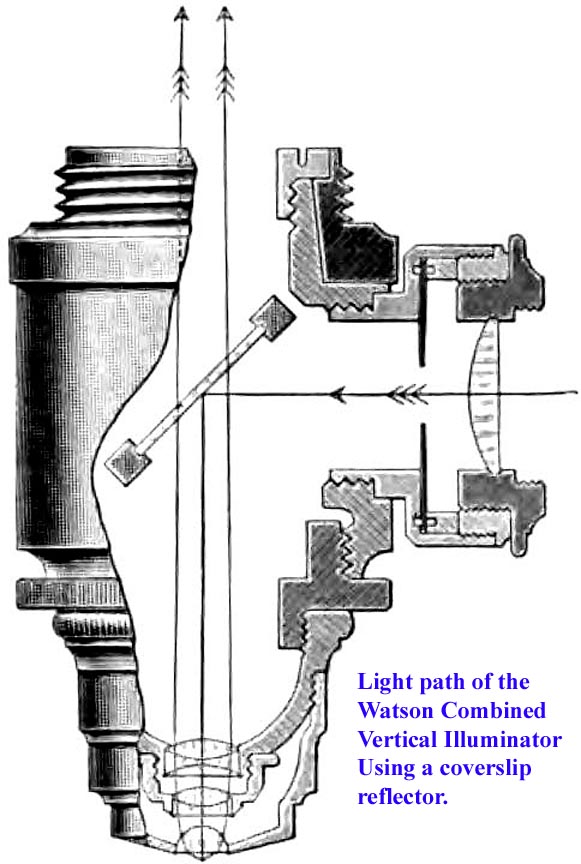MICROSCOPE-ANTIQUES.COM © 2013-15.
WATSON COMBINED VERTICAL ILLUMINATOR
c. 1926
Maker: W. WATSON & SONS LTD.

 Watson's 'Combined Vertical Illuminator' set comes in a signed case, providing the option of a tiny prism or coverslip for reflecting the illuminating light beam.
The Watson 'Combined Vertical Illumintor' was first offered by Watson after 1921, and is shown in the 1923 catalog (thanks to Dr Joe Zeligs for this information). This system not only offers two different types of reflectors, but also features a built-in condensing lens and an iris diaphragm, improvements over the simple apertures of the more basic earlier types. It also has adjustment for centration of the prism or glass reflector.
Watson's 'Combined Vertical Illuminator' set comes in a signed case, providing the option of a tiny prism or coverslip for reflecting the illuminating light beam.
The Watson 'Combined Vertical Illumintor' was first offered by Watson after 1921, and is shown in the 1923 catalog (thanks to Dr Joe Zeligs for this information). This system not only offers two different types of reflectors, but also features a built-in condensing lens and an iris diaphragm, improvements over the simple apertures of the more basic earlier types. It also has adjustment for centration of the prism or glass reflector.
Vertical illuminators are used for
illumination of solid or opaque objects with higher power objectives.
Although with low power, top-illumination from the side can suffice, as the
magnification increases and the focal length shortens, light cannot
easily be directed onto the top of an opaque specimen. The vertical
illuminators allow the light to come down onto the specimen from above
through the objective, by reflecting incoming light off a coverslip at
an angle, or via a tiny prism or mirror which at
the same time allows the reflected light to pass
back up in the opposite direction reaching the eyepiece. With the
coverslip type the reflected light goes up through the coverslip; with
the tiny prism, it is so small, light is able to pass up the
illuminator around it. These arrangements both have disadvantages and many years later, more inventive and efficient methods of illuminating opaque objects were developed. These included better vertical illuminators and also directing light downward around the outside edge of specially designed 'Epi' objectives. Examples of modern microscopes providing this type of lighting are in this collection including a Olympus Vanox with vertical illumination, and a Wild Epi-illumination system.

 Watson's 'Combined Vertical Illuminator' set comes in a signed case, providing the option of a tiny prism or coverslip for reflecting the illuminating light beam.
The Watson 'Combined Vertical Illumintor' was first offered by Watson after 1921, and is shown in the 1923 catalog (thanks to Dr Joe Zeligs for this information). This system not only offers two different types of reflectors, but also features a built-in condensing lens and an iris diaphragm, improvements over the simple apertures of the more basic earlier types. It also has adjustment for centration of the prism or glass reflector.
Watson's 'Combined Vertical Illuminator' set comes in a signed case, providing the option of a tiny prism or coverslip for reflecting the illuminating light beam.
The Watson 'Combined Vertical Illumintor' was first offered by Watson after 1921, and is shown in the 1923 catalog (thanks to Dr Joe Zeligs for this information). This system not only offers two different types of reflectors, but also features a built-in condensing lens and an iris diaphragm, improvements over the simple apertures of the more basic earlier types. It also has adjustment for centration of the prism or glass reflector.